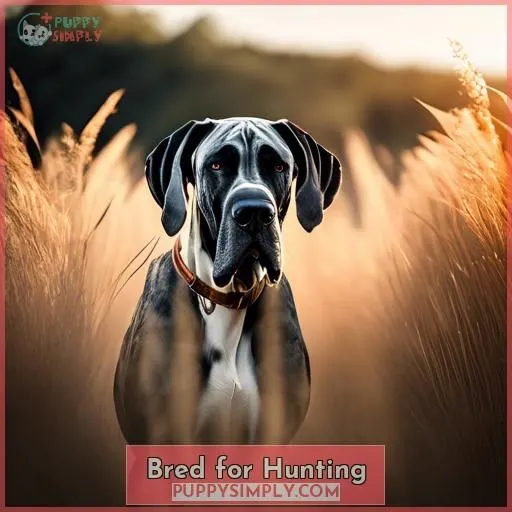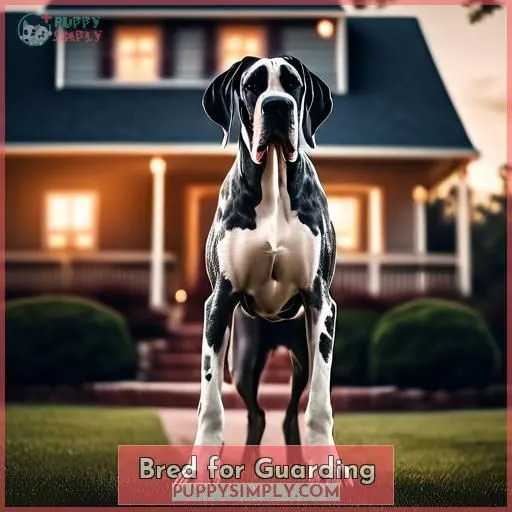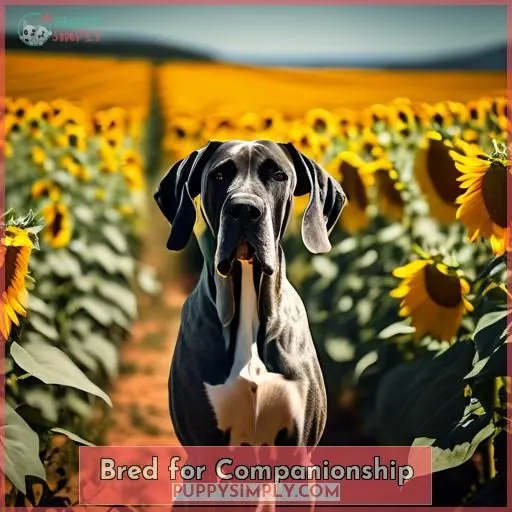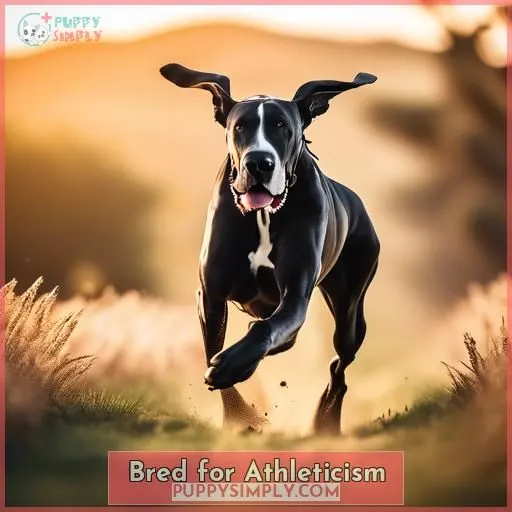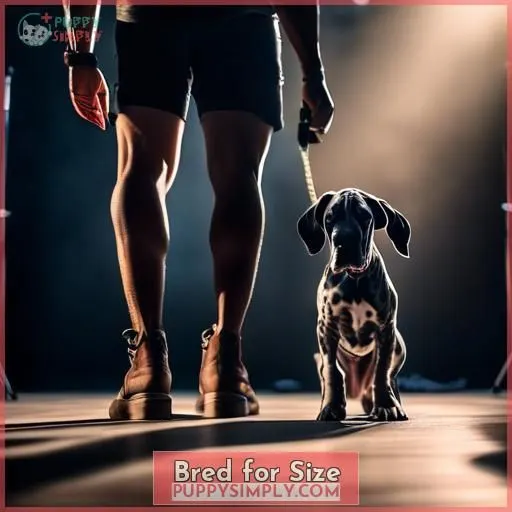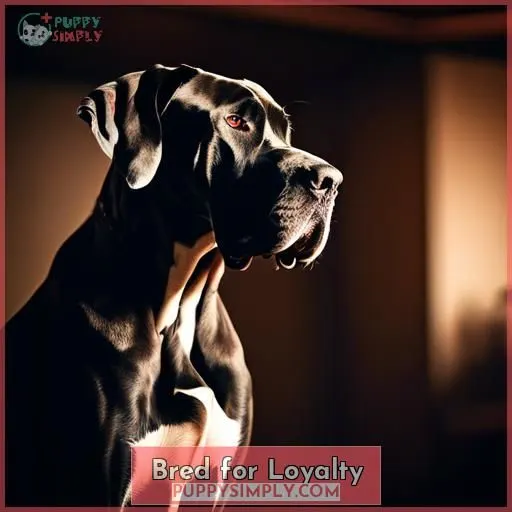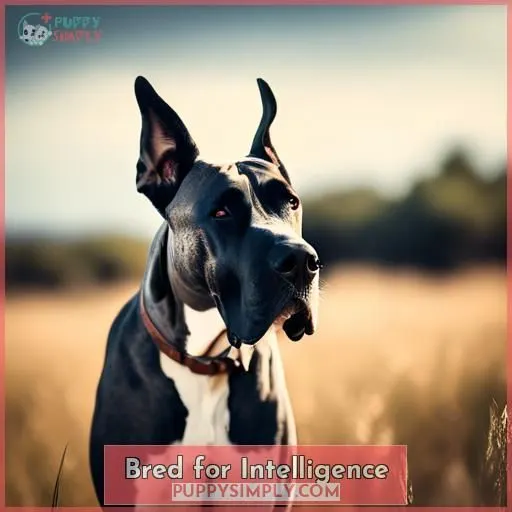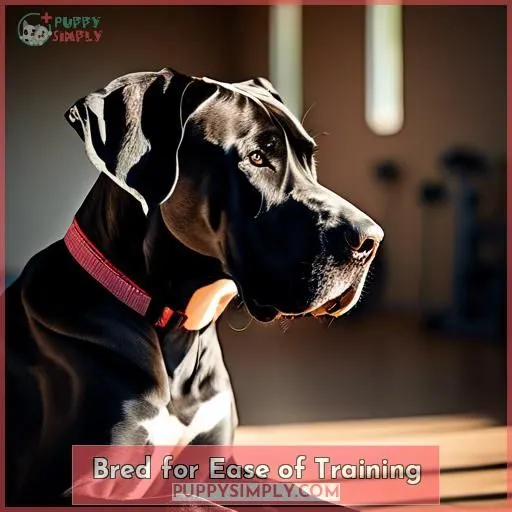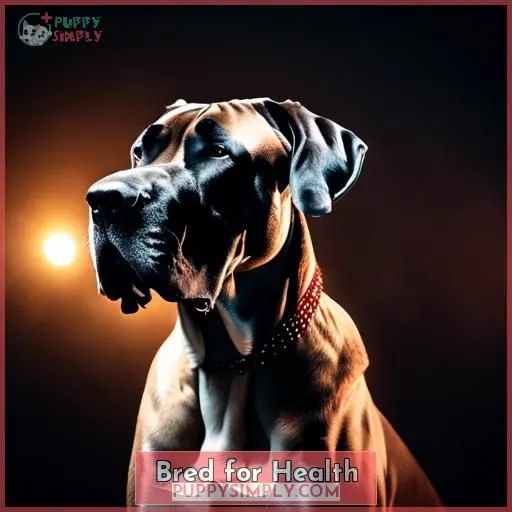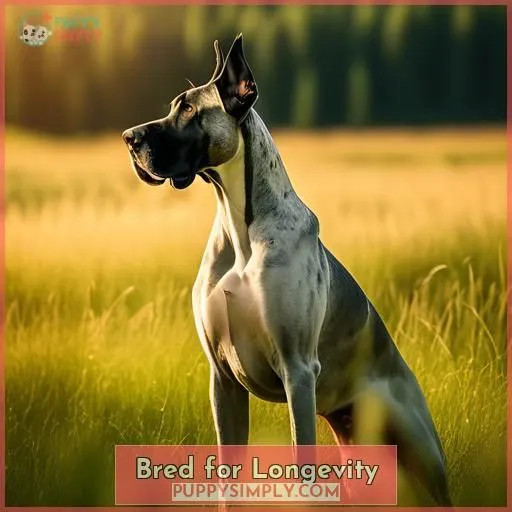This site is supported by our readers. We may earn a commission, at no cost to you, if you purchase through links.
 Like gentle giants awaiting their call to service, Great Danes were originally bred for hunting boar and guarding estates.
Like gentle giants awaiting their call to service, Great Danes were originally bred for hunting boar and guarding estates.
You’ll be surprised by their versatility – these dogs excelled in tasks requiring size, strength, and unwavering loyalty.
From flushing quarry to safeguarding families, Great Danes’ multifaceted talents showcase their intelligence and eagerness to work alongside humans.
Table Of Contents
Key Takeaways
- Bred for hunting and guarding
- Gentle nature and affectionate demeanor
- Athletic and require daily exercise
- Size and strength make them excellent protectors
What Are Great Danes Bred For ?
Great Danes were originally bred for hunting wild boars.
Bred for Hunting
Bred for Hunting: The Great Dane’s Ancestral Roots
The Great Dane, a breed known for its impressive size and noble demeanor, has a rich history that dates back to the Middle Ages. Originally, these dogs were bred for hunting, specifically for boar hunting. In the heart of Germany, the breed’s ancestors were used to hunt wild boar, bears, and deer, showcasing their strength, agility, and endurance.
These dogs weren’t only skilled hunters but also served as guardian dogs for German nobility. They were the epitome of a working breed, designed to enhance their owners’ hunting experiences and protect their homes.
Their hunting instincts and loyalty made them an indispensable part of the German nobility’s lifestyle.
As hunting customs evolved, particularly due to the use of firearms, many of the involved dog types disappeared. The Great Dane became rare and was kept only as a dog of hobby or luxury. However, their hunting roots remained a part of their identity, and their reputation as gentle giants continued to grow.
In the realm of hunting, the Great Dane was a catch dog used after the other hunting dogs to seize the bear or boar and hold it in place until the hunter arrived. Their size and strength were crucial in immobilizing their prey, making them an essential asset in the hunting process.
Although their primary role has shifted from hunting to companionship, the Great Dane’s heritage as a hunting breed still underpins their physical and behavioral traits. They continue to be known for their courage, friendliness, and dependability, traits that are reminiscent of their ancestral roots in the hunting world.
Bred for Guarding
Great Danes were originally bred for guarding due to their intimidating size and strength. Their instinctual guarding behavior and territoriality make them excellent protectors. Training for guarding involves teaching them to recognize potential threats and respond accordingly, while being cautious of the disadvantages of guarding dogs, such as potential aggression and the need for careful socialization.
Bred for Companionship
As we delve deeper into the world of Great Danes, it’s time to explore the subtopic of ‘Bred for Companionship’. These majestic creatures weren’t only bred for their imposing size and strength but also for their gentle nature and affectionate demeanor.
They were designed to be the ‘Apollo of dogs’, known for their grace, courage, and beauty.
Great Danes were bred for beauty, not just in their physical appearance but also in their disposition. They’re bred for affection, making them highly social dogs that crave companionship. They’re bred for loyalty, making them faithful companions and protectors. They’re bred for family, making them suitable companions for families with children.
They’re even bred for therapy, providing comfort and companionship to those in need.
These gentle giants are easy to train, making them a joy to be around. They’re patient and gentle, making them great with kids, but they do require supervision. They’re eager to please and easy to train, but they may be stubborn at times. Despite their size, they aren’t intimidating watchdogs but fair protection dogs.
They’re usually friendly towards other dogs and housemates, making them a great addition to any family.
In conclusion, Great Danes were bred for companionship, not just for their size or strength. They’re bred to be the ‘Apollo of dogs’, elegant and regal in gait and disposition, and they require lots of affection and socialization.
They’re a grand danois, a gentle giant that brings great joy and companionship to those who can provide for their needs.
Bred for Athleticism
Moving on from companionship, let’s dive into the athleticism of the Great Danes. These tallest dogs in the world aren’t just impressive in stature, but also in their agility and energy. They were originally bred for hunting and guarding, and their athleticism is a testament to their heritage.
Great Danes are known for their participation in dog sports like Agility and Obedience, showcasing their speed, strength, and intelligence. They require daily exercise, including two brisk walks, to keep their muscles toned and their minds engaged.
But it’s not just about physical prowess. Proper training is essential to harness their athleticism and prevent them from following their noses and wandering off. With the right guidance, they can become obedient and skilled hunters, trackers, and retrievers.
So, if you’re looking for a dog that can keep up with your active lifestyle, the Great Dane is a breed that can’t only meet your expectations but also surpass them.
Bred for Size
Great Danes are known for their impressive size and stature, with males reaching up to 32 inches at the shoulder and weighing between 110-175 pounds. Their physical structure is characterized by a massive head, long, strong neck, and a thick, medium-length tail.
The breed’s size variations are significant, with some individuals weighing as little as 60-85 pounds and standing around 24-28 inches tall at six months old.
Great Danes aren’t the world’s largest dog breed, as the Irish Wolfhound surpasses them in height. However, they’re still considered one of the largest breeds, with their size and weight contributing to their intimidating appearance.
Despite their size, Great Danes are known for their gentle and friendly nature, making them suitable companions for families.
The breed’s size requires a large living space and a secure yard, as well as a large vehicle for transportation. Great Danes are also prone to certain health conditions due to their size, such as hip dysplasia and bloat.
To ensure their health and longevity, it’s essential to provide them with proper care, including regular vet checkups and a balanced diet.
In conclusion, Great Danes were originally bred for their size and strength, which made them suitable for hunting and guarding tasks. Today, they’re cherished for their gentle and affectionate nature, which makes them excellent companions for families.
However, their size requires careful consideration and a commitment to providing them with the space, care, and attention they need to thrive.
Bred for Loyalty
When you’re looking for a four-legged companion that embodies loyalty, you can’t go wrong with a Great Dane. These gentle giants weren’t just bred for boar hunting; they were also shaped to be steadfast family protectors and loyal friends.
Their innate sense of loyalty makes them excellent choices for all ages, providing both emotional support and therapy animal qualities. They’re the kind of social family pets that won’t raise a ruckus with barking without good reason.
Here’s a fun table to break it down:
| Quality | Great Dane | Benefit |
|---|---|---|
| Loyalty | Top-notch | Peace of mind |
| Social | Loves company | Perfect family pet |
| Calm | No needless barking | Quiet companion |
These dogs are more than just pets; they’re heartwarming additions to any home, offering a sense of belonging and power in their silent support.
Bred for Intelligence
You might be surprised to learn that Great Danes are actually quite intelligent pups!
While they may not be the sharpest tools in the shed, these gentle giants have a knack for problem-solving and adaptability that sets them apart.
Their obedience intelligence may be average, but their ability to learn new tricks and engage in interactive play is truly impressive.
Don’t let their size fool you – these dogs are quick learners and eager to please their owners.
Of course, their intelligence does come with some caveats, as Great Danes can be prone to hearing and vision problems.
But with the right training and care, these versatile pups can truly shine, proving that brains and brawn can go hand-in-hand.
Bred for Ease of Training
Great Danes were bred to be easy to train, thanks to their eager-to-please nature and intelligence. These gentle giants thrive on positive reinforcement and crave praise from their owners. With consistent training from an early age, you can teach your Dane all the basics – and even some fun tricks! Just be mindful of their massive size when choosing commands.
While they may be stubborn at times, a little patience goes a long way. And don’t forget socialization – it’s key for these pups to feel comfortable around new people and animals. With the right training approach, your Great Dane will become a well-behaved, devoted companion.
Just be prepared to provide plenty of space, large-breed puppy food, and veterinary care for their unique needs.
Bred for Health
As a Great Dane owner, you’ll need to be on the lookout for their unique health needs. These gentle giants are prone to certain genetic disorders like cardiomyopathy and hip dysplasia due to their massive size.
Proper nutrition is crucial – they require large-breed puppy food to support their slow, steady growth and avoid joint issues.
Exercise is also tricky, as they shouldn’t run until after two years old. Vet bills can add up quickly, so budget for regular checkups and any specialized care. Despite their short lifespan, you can help your Dane thrive by staying on top of their health.
Their striking coats come in diverse colors like black, blue, and harlequin, but require minimal grooming beyond shedding season.
Bred for Longevity
While Great Danes may be the tallest of the working breeds, their impressive size comes with a trade-off – a shorter lifespan. On average, these gentle giants only live 7 to 10 years, far less than the typical canine.
- Gastric dilatation volvulus (GDV), a life-threatening bloating issue
- Cardiomyopathy, a weakening of the heart muscle
- Hip dysplasia, a painful joint disorder
To help your Great Dane live their best life, provide soft bedding, an emergency stretcher, and proper post-op care if needed. With the right care and attention, you can maximize their precious time with you, despite their breed’s low life expectancy.
Frequently Asked Questions (FAQs)
What are the common health issues faced by Great Danes?
You’ll face issues like hip/elbow dysplasia, bloat, cardiomyopathy, and shorter lifespans of 7-10 years with these gentle giants.
How often should a Great Dane be exercised?
You’ll want to provide your Great Dane with two brisk walks daily – one in the morning, one at night.
What is the typical lifespan of a Great Dane?
You’re in for a bittersweet journey. Great Danes typically live around 7-10 years, their giant size contributing to their relatively short lifespan.
Can Great Danes be used for hunting in modern times?
Absolutely! Picture hunting a wild boar with your Great Dane by your side. Their courage, size, and strength make them perfect modern-day hunting companions.
How does the size of a Great Dane affect its temperament?
You’d be surprised – their giant size makes Great Danes incredibly gentle, patient pals. Their mellow nature stems from being bred to hunt quietly and calmly alongside humans.
Conclusion
Proudly parading their pedigree, Great Danes were bred for boar-bashing bravery, estate-guarding grit, and human-adoring allegiance. You’ll uncover this breed’s brilliant versatility – size supporting strength, smarts enabling service spanning security to sport.
Delightfully dependable, diligently devoted, Great Danes deliver dazzling diversity deserving of devotion.

